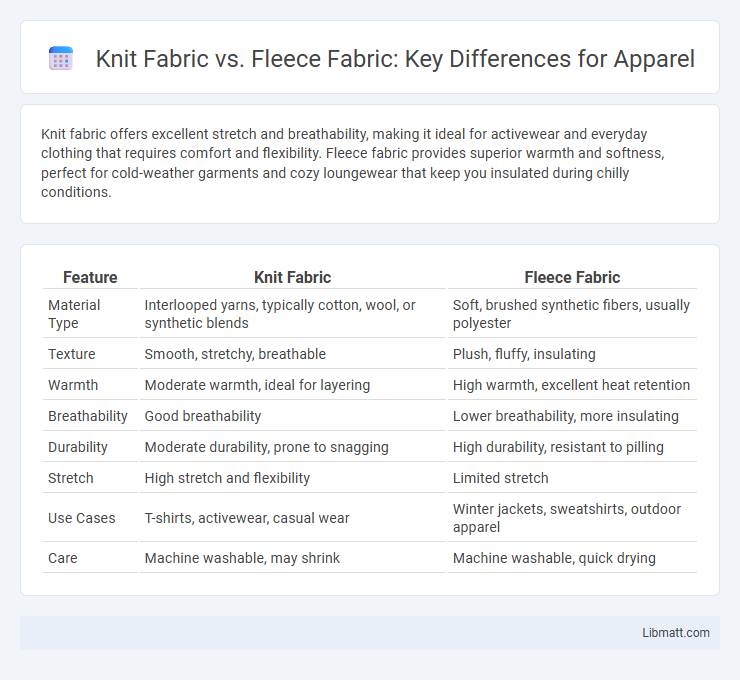Knit fabric offers excellent stretch and breathability, making it ideal for activewear and everyday clothing that requires comfort and flexibility. Fleece fabric provides superior warmth and softness, perfect for cold-weather garments and cozy loungewear that keep you insulated during chilly conditions.
Table of Comparison
| Feature | Knit Fabric | Fleece Fabric |
|---|---|---|
| Material Type | Interlooped yarns, typically cotton, wool, or synthetic blends | Soft, brushed synthetic fibers, usually polyester |
| Texture | Smooth, stretchy, breathable | Plush, fluffy, insulating |
| Warmth | Moderate warmth, ideal for layering | High warmth, excellent heat retention |
| Breathability | Good breathability | Lower breathability, more insulating |
| Durability | Moderate durability, prone to snagging | High durability, resistant to pilling |
| Stretch | High stretch and flexibility | Limited stretch |
| Use Cases | T-shirts, activewear, casual wear | Winter jackets, sweatshirts, outdoor apparel |
| Care | Machine washable, may shrink | Machine washable, quick drying |
Introduction: Understanding Knit and Fleece Fabrics
Knit fabric features interlocking loops of yarn, creating a stretchy, breathable material ideal for apparel requiring comfort and flexibility. Fleece fabric is typically made from polyester with a brushed surface that traps heat, offering superior warmth and softness for cold weather garments. Understanding these core differences helps you select the appropriate fabric based on your needs for breathability or insulation.
What is Knit Fabric?
Knit fabric is a textile created by interlocking loops of yarn, offering exceptional stretch, breathability, and flexibility, ideal for activewear and casual garments. Common types of knit fabrics include jersey, rib knit, and interlock, each varying in texture and durability. Its structure allows for excellent moisture-wicking properties and comfort, distinguishing it from woven fabrics and fleece.
What is Fleece Fabric?
Fleece fabric is a soft, insulating textile made from synthetic fibers like polyester, designed to retain heat and provide warmth. It features a brushed surface that creates a plush texture, making it ideal for cold weather clothing and outdoor gear. Unlike knit fabric, fleece offers superior moisture-wicking properties and enhanced thermal insulation.
Composition and Structure: Knit vs Fleece
Knit fabric is created by interlocking loops of yarn, typically composed of cotton, wool, or synthetic fibers, resulting in a stretchy and breathable material ideal for apparel. Fleece fabric, commonly made from polyester or a polyester blend, features a brushed, napped surface that traps air for insulation and superior warmth. The structural difference lies in knit's looped construction providing flexibility, while fleece's piled texture enhances thermal retention and softness.
Texture and Feel: Comfort Comparison
Knit fabric features a smooth, stretchy texture that molds comfortably to your body, offering breathability and flexibility ideal for everyday wear. Fleece fabric, on the other hand, provides a soft, plush surface with insulating properties that trap warmth, making it perfect for cold weather comfort. Your choice between these fabrics depends on whether you prioritize lightweight flexibility or cozy insulation for ultimate comfort.
Breathability and Warmth Differences
Knit fabric offers superior breathability due to its open, looped structure that allows air circulation, making it ideal for moisture-wicking and temperature regulation. Fleece fabric, constructed from synthetic fibers like polyester, provides exceptional warmth by trapping heat within its dense, brushed pile, but it is less breathable and can retain moisture. These differences influence their performance in various climates, with knit fabrics preferred for active wear in mild conditions and fleece favored for insulation in colder environments.
Durability and Maintenance
Knit fabric offers excellent durability due to its interlocking loops, making it resistant to stretching and tearing, while fleece fabric, made from synthetic fibers, provides warmth but may pill over time with frequent washing. Your choice depends on maintenance preferences; knit fabrics typically require gentle care and less frequent washing, whereas fleece needs regular cleaning to maintain softness and prevent odor buildup. Both fabrics are machine washable, but knit fabric often retains its shape better after laundering compared to fleece.
Best Uses and Applications
Knit fabric excels in clothing that requires stretch and breathability, such as activewear, t-shirts, and lightweight sweaters, providing comfort and flexibility for daily wear. Fleece fabric is ideal for cold-weather apparel like jackets, hoodies, and blankets due to its superior insulation and moisture-wicking properties. Both fabrics serve distinct purposes: knit fabric suits warm-weather and form-fitting garments, while fleece is preferred for thermal insulation and outdoor activities.
Environmental Impact of Knit and Fleece
Knit fabric, often made from natural fibers like cotton or wool, generally has a lower environmental footprint due to its biodegradability and reduced microplastic pollution compared to synthetic fleece, which is typically polyester-based and derived from petroleum. The production of fleece involves higher energy consumption and releases greenhouse gases contributing to climate change, while knit fabrics can have a more sustainable lifecycle if sourced responsibly. You can reduce your environmental impact by choosing organic knit fabrics or recycled fleece options that minimize waste and resource use.
Which Fabric Should You Choose?
Knit fabric offers excellent stretch and breathability, making it ideal for activewear and casual clothing, while fleece fabric provides superior warmth and insulation, perfect for cold-weather garments and cozy loungewear. Your choice depends on whether you prioritize comfort and flexibility or warmth and softness in your apparel. Both fabrics have unique textures and performance qualities that suit different lifestyles and seasonal needs.
Knit Fabric vs Fleece Fabric Infographic

 libmatt.com
libmatt.com